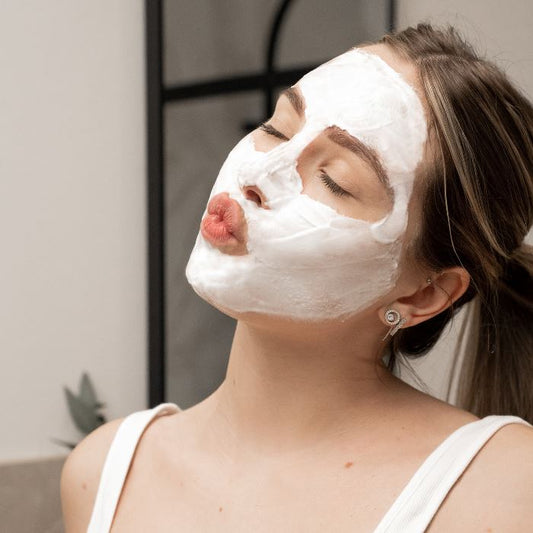The truth about sunscreen

Topicrem celebrates its 30th anniversary!
0,00€
Much more than a summer accessory, sunscreen should be the essential treatment to adopt in your routine, all year round. At TOPICREM, we provide very high protection to your skin every day, through a selection of dedicated treatments.
The sun's rays come in several distinct categories, each with specific implications for skin health:

First of all, understanding the meaning of protection indices is essential to choosing the right sunscreen for your needs. If you browse our HYDRA + , MELA and CALM + ranges you will see this acronym: SPF , meaning “Sun Protection Factor” in French. This index is a key element to take into account when choosing your cream.
The difference between SPF 30 and SPF 50 is minimal . If you want to know more about UV indices and how they affect your skin, we recommend reading our article on the effects of the sun on your skin
Beyond sun filters, choose products containing additional active ingredients ensuring internal biological protection of your skin cells (echinacea extract, vitamin E, etc.).
Prefer compositions that have been rigorously tested to assess their impact on marine biodiversity , thus ensuring that this will be as minimal as possible.
If you have sensitive or allergy-prone skin , look for formulas that have been tested on this target . For oily skin , opt for non-comedogenic and lightweight formulations that won't clog pores. Explore our SUN PROTECT sun care range , designed to meet the needs of even the most delicate skin.
Also adapt the choice of your sun protection to your needs and your phototype , this allows you to classify your skin according to its reaction to the sun and its sensitivity to UV rays .
If you plan to swim or sweat, choose water-resistant sunscreen and reapply it regularly , especially after swimming or sweating.
On summer days, sunscreen is a natural part of your routine. Indeed, taking care of your skin and protecting it daily is essential.

Even on cloudy days, UV rays are present and can be harmful, especially UVA rays.
Did you know that our environment also reflects the sun's rays? So, even lying in the shade on the grass, your environment exposes you to the sun's rays . Sunscreen becomes your essential ally, use it without moderation!

In practice, many users tend to underestimate the recommendations of dermatologists: generous application is essential for optimal protection against UV rays.
The ideal is to cover our entire body with 35g of sunscreen, which is equivalent to 7 teaspoons.¹
Apply a generous line of sunscreen from the tip of your middle finger to your wrist , then apply it to every part of your body. For spray sunscreens, this works out to 15 sprays on each area of your body. And your skin will be protected.

Preserve and protect your skin with TOPICREM personalized care solutions.
At TOPICREM , we design treatments combining sun protection and well-being. Available in several formulations, they adapt to your skin type . Made up of sun filters, our products offer protection against UVA and UVB while hydrating and nourishing your skin.
TOPICREM, for each sensitive skin, a dedicated solution!
You want to integrate effective sun protection into your daily routine, while combining optimal hydration . Our HYDRA+ PROTECTIVE DAY CREAM SPF50 is the one you need. Thanks to high SPF50 PA++++ protection and its postbiotic complex , this cream brings hydration and radiance to your skin. Fragrance-free and non-comedogenic , it adapts to all skin types and leaves no white marks
To protect your skin from pigment spots during sun exposure, choose our MELA ANTI-DARK UNIFYING DAY CREAM SPF50+ . Its combination of the MELA complex with sun filters and a dipeptide offers protection against the harmful effects of UV and blue light while acting on your existing spots .
Did you know ? Studies show that the blue light emitted by your digital devices excessively stimulates melanocytes, thus promoting the appearance of pigment spots.
If your skin is reactive or prone to rosacea , opt for our CALM+ DAILY ANTI-REDNESS CREAM . This facial treatment reduces and helps prevent visible redness thanks to its active ingredient Centella Asiatica, while ensuring optimal SPF50+ protection with broad UVA/UVB spectrum . This cream is ideal as a makeup base!
Discover our commitment to sensitive skin with our HYDRA+ RADIANCE TINTED CREAM SPF50+ , a 3-in-1 treatment offering coverage, sun protection and hydration . The little extra of this cream? Its pigments, which effectively camouflage irregularities and imperfections .
Result : an even and radiant complexion, with double defense against pollution and UV rays.
Certain ingredients and formulations found in sunscreen should be avoided due to their potential impact on your health and the environment . Here is a brief list:
After expiry dates, certain components may present health risks. A practical tip: sometimes solar products display a pictogram representing an open jar accompanied by a number followed by the letter “M”. This indication represents the duration in months during which the product can be kept after opening. In any case, it is not recommended to use a sunscreen product from one year to the next.
Practical, simple, but essential , sunscreen should not be a summer option, but an essential all year round . Make the health of your skin a priority with products adapted to its needs and take full advantage of each sunny day with complete peace of mind.
¹WULF HC & al. The relationship between sun protection factor and amount of sunscreen applied in vivo. British Journal of Dermatology (2007).

Exposing yourself to the sun is generally a pleasant time. But for it to remain so, certain impor...
Read the article
It beautifies our life and our complexion, warms us, and is essential to our well-being. However,...
Read the article
If you want to spend more time with your skin, TOPICREM has a few tips for an uncomplicated routi...
Read the article
Adapt your beauty routine to your needs, and take the time to do yourself good!
Read the article



